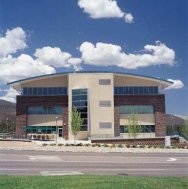
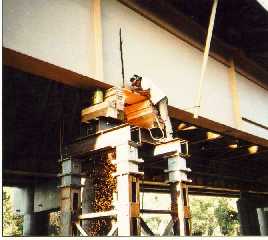
To date, field verification of damage detection algorithms applied to large civil engineering structures are scarce as few full size structures are made available for such destructive testing. Because the I-40 bridges over the Rio Grande in Albuquerque, New Mexico were to be demolished and replaced, the investigators were able to introduce simulated cracks into the structure, perform vibration test before and after each level of damage had been introduced, and then use the test data to validate various damage ID methods. Staff from LANL and SNL performed experimental modal analyses on the bridge in its undamaged and damaged conditions. Researchers from Texas A&M University subsequently applied a damage detection algorithm to these data. The same damage detection algorithm was independently applied by the LANL staff to these data and to numerical data from finite element simulations of the I-40 bridge where other damage scenarios were investigated. The data required by the damage ID algorithm are mode shapes and resonant frequencies for the damaged and undamaged bridge. Results from these investigations are some of the first comparative studies of various damage ID algorithms that have been reported in the technical literature.
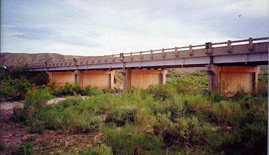
The Alamosa Canyon Bridge in southern New Mexico has been designated as a bridge test facility by the New Mexico State Highway and Transportation Department. Numerous modal tests have been performed on this structure for the purposes of damage detection. With only limited abilities to introduce damage into this structure, recent tests have focused on quantifying the statistical variations in modal properties that result from changing environmental conditions. It is imperative that these changes be quantified and that changes resulting from damage are shown to be either greater than or different from those resulting from the test-to-test variations. Recent tests have been performed with the intent of comparing different statistical analysis procedures.
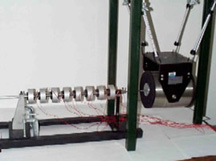
An attempt was made to identify and characterize known nonlinearities of an 8 Degree-of-Freedom (DOF) mass-spring system through various damage detection methods. A known nonlinearity in the 8 DOF system is a "bumper" consisting of tiny aluminum bars with felt pads on the tips. After data is taken without the bumper installed (the assumed linear system), the bumper is then placed between two of the masses to introduce a known nonlinearity. Both frequency and time domain methods are being explored with this data set.
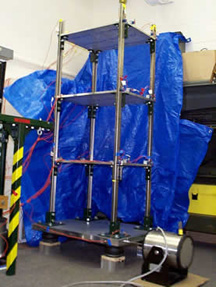
The Bookshelf structure is a three-story frame structure model. The structure is constructed of Unistrut columns and aluminium floor plates. The floors are 1.3 cm (0.5 in) thick aluminium plates with two-bolt connections to brackets on the Unistrut. The base is a 3.8 cm thick (1.5 in) aluminium plate. Support brackets for the columns are bolted to this plate and hold the Unistrut columns. All bolted connections are tightened to a torque of 0.7 Nm (60 inch-pounds) in the undamaged state and hand tight or rattling in damaged states. Four Firestone air mount isolators, which allowed the structure to move freely in horizontal directions, are bolted to the bottom of the base plate. The isolators are inflated to 140 kPa gauge (20 psig) and then adjusted to allow the structure to sit level with the shaker. The shaker is coupled to the structure by a 15 cm (6 in) long, 9.5-mm (0.375-in) diameter stinger connected to a tapped hole at the mid-height of the base plate. The shaker is attached at corner D as shown in Figure 9, so that both translational and torsional motions can be excited.
The structure is instrumented with 24 piezoelectric single axis accelerometers, two per joint as shown in Figure 9. Accelerometers are mounted on the aluminum blocks that are attached by hot glue to the plate and column. This configuration allows relative motion between the column and the floor to be detected. The nominal sensitivity of each accelerometer is 1 V/g. A 10 mV/lb force transducer is also mounted between the stinger and the base plate. This force transducer is used to measure the input to the base of the structure. A commercial data acquisition system controlled from a laptop PC is used to digitize the accelerometer and force transducer analog signals.

This structure was developed to demonstrate the LANL damage detection methods on the road. The simple aluminum frame structure consists of two monitored joints with piezo ceramic actuators which can incrimentally loosen the joint over time. The structure is excited with a small shaker powered by a laptop computer which is also used for data collection. Look for the LANL portal structure to appear at a conference near you.
